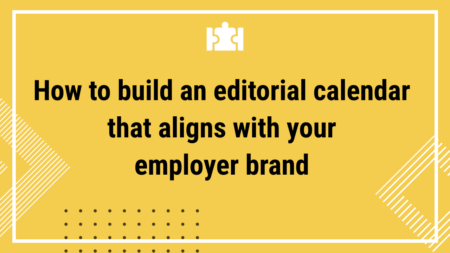Every organization cares about employee retention, and it’s no secret that losing employees means losing productivity, lowering morale of current employees, and decreasing brand reputation. The road to retaining top talent is paved with challenges, and 2022 was living proof that no matter how exciting an organization seems to be, at the end of the day it all comes down to its ability to provide a stable, healthy work environment.
Amid economic uncertainty, leaders are becoming fearful of what the future holds. But as the holiday season knocks on our door, maybe it’s a good time to reflect, reassess and rethink recruitment, starting with the EVP all the way to retention and everything in between.

EVP 2.0 – out with the old, in with the new
According to Gartner, companies with a transparent EVP are capable of decreasing annual employee turnover by almost 70%, boosting commitment among new hires by 30%. Furthermore, 57% of recruiters today pinpoint that their biggest challenge is understanding how their company differs from the competition. Amid such turmoil in the candidate market, it pays to know how a transparent EVP can be used to attract and retain top talent.
Out with the old, in with the new
An employee value proposition (EVP) is a company’s X best set of employee benefits (financial and non-financial). For decades, leaders have been using perks to retain employees and keep them motivated enough so that they don’t leave. And yet, it seems that no amount of perks can replace the fact that EVPs in general lack transparency.
In the past 2 years, employees were given the chance to experience what lies underneath beautifully wrapped company EVPs. Some of them lashed out after being laid off amid the pandemic, while others realized that the companies they were working for don’t deserve their skills and commitment.
The Great Resignation followed and with it employees took their power back, triggering a booming candidate job market; a new job market that forced businesses to reconsider what they thought an EVP was. And yet, it looks like only 31% of companies use employee surveys to build an accurate employee value proposition, with merely 13% conducting focus groups.
An ecosystem of values, support & recognition, not just a set of benefits
Once treated as a set of benefits, today’s EVP is a full-blown ecosystem; an ecosystem of values, support, and recognition that employers must offer to their employees for them to perform at their best.
An efficient EVP enables recruitment professionals and organizations at large to set up a strong (and honest) employer brand. We’ve seen companies reframe and reassess their company values, and that proves to us that culture matters. Candidates want to join companies that care about them as people.
Why EVP matters?
An EVP helps organizations get closer to fulfilling one of their core goals: to become an employer of choice. Done right, it provides a straightforward answer to the question Why would a highly skilled and talented candidate join us?
Apart from improving retention, an EVP provides a competitive edge. It streamlines talent management, narrowing the recruitment funnel and targeting the right people for specific open roles. In short the top reasons for developing an EVP are:
- More transparency in attracting top talent
- Improved retention
- Optimized recruitment expenses
- Improved corporate culture
- Superior employee experience
Considering historic increases in inflation, money is important in retaining employees. And yet, a recent study done by PwC, highlights that’s not enough.
“Job fulfillment and the ability to be one’s true self at work were ranked second and third among employees considering a job change. These findings align with our 2021 survey results, in which 75% of employees said they wanted to work for an organization that makes a positive contribution to society, and fully half reported experiencing discrimination at work.”
Your EVP will change over time. It’s not static and it should be constantly monitored and updated to match your culture. Every 6 months, we highly recommend that you revisit your EVP to make sure it still resonates with your people.
The more strategic you are with implementation throughout your candidate persona’s journey the better chances you have to communicate clearly how it feels to work at your company.

Your Careers Page, your recruitment anchor
Picture your Careers Page like a boat’s anchor. Your employer brand is the boat. Without the anchor, the boat floats in different directions, sharing information of all sorts and kinds in a social media ocean. To stabilize the boat, so that people can step aboard, you need that anchor, aka your Careers Page.
A Careers Page keeps your employer brand centered
Before we discuss the key elements of building a successful Careers Page, let’s talk about the importance of using your employer brand identity to build content that sticks. Over time, your employer brand and EVP will change, and that’s perfectly natural. The key is to adapt the messaging and constantly update the content on your Careers Page as you grow and scale.
Consistency and clarity keep you centered. As an employer, you want your audience to look beyond the surface. It’s cool to talk about values, purpose, mission, and vision. But how do you give them substance? This is the part where you walk the talk in employer branding.
If “transparency” is added to your Careers Page as a core value, think of ways you can prove that. The same goes for other values like “autonomy”, “teamwork”, etc. Leverage different types of media to share your story, such as video and text. Last but not least, don’t ignore web design. Your Careers Page should be intuitive, user-friendly, and easy to access.
Don’t get lost in content
It’s tempting to want to make your Careers Page look as fluffy as possible. Avoid that temptation by setting some priorities. The aim of such a page is to convince viewers to take some sort of action upon arrival. However, if you can’t grab their attention from the first few seconds, chances are they’re exit. So how do you keep candidates scrolling and hopefully clicking and applying to your open roles?
- Make it easy to spot from your main website. A tiny “Careers/Jobs” button in the footer of your website won’t cut it
- Build it from scratch & brainstorm a structure
- Make it easy to read & intuitive (design and user experience matter)
- Include content that appeals to your candidate persona (e.g. company story, values, reasons to join your company, employee testimonials)
- Use the right CTAs
Considerations to have in mind when building your strategy
How do you build a successful Careers Page strategy? The ideal approach is to gather insights from newly hired employees. Ask them what they would have liked to see on such a page. What did they like or dislike about your current Carees Page? What aspects would they improve?
It might be a good idea to check out some of the Careers Pages of your competitors just to collect some more feedback. And last but not least, make sure your strategy also includes analytics. Monitoring page visitors, bounce rate, time spent on page, clicks, etc. matters because it will help you understand user behavior, and whether or not further improvements need to be made.
There’s no right or wrong way for building a Careers Page to help expand your recruitment attempts. What matters most is to make sure your content is put in the right context; and that your content tells the story of your employer brand. Keep in mind that ongoing improvements are vital, and along the way, you’ll probably make a lot of mistakes. And that’s ok. Get the first iteration out there and work your way to polish it along the way!

Break the traditional recruitment loop.
Recruiting qualified candidates is easier said than done. Having a user-friendly, beautifully designed Careers Page will certainly help strengthen your employer brand. However, it all comes down to the application process.
No Careers Page will convince candidates to ‘Apply now!’ if the process takes more than 2 minutes. In tech, companies have yet to understand that candidates want to be impressed. Certainly, a 10-step application process won’t help you narrow down the screening process.
Consider the ‘Easy Apply’ feature from LinkedIn
Technical roles such as software engineers, architects, DevOps, and others feature numerous sub-skills. Employers usually post them in job descriptions. Testing someone’s expertise matters. Portfolios and past works are also important. We get it, before even considering a candidate, you want to screen out the unqualified.
Don’t make the application process content-heavy. 40% of interested candidates drop out instantly if they must go through 20 screening questions. Content-heavy job descriptions and elaborate questions create resistance, deterring candidates from the actual job role, no matter its greatness. Content matters just as much as context in this phase, so make it meaningful not obvious.
But a long and tedious application process won’t cut it. Not in today’s job market! You might have a chance with the ‘Easy Apply’ feature from LinkedIn. In the end, the LinkedIn profile of a candidate might prove to be better than a resume.
Switch your focus – from expertise to the human behind the expertise
Have you ever recruited a hidden gem? Underneath the vast experience of a tech professional lies a human being with feelings, needs, and wants just like everyone else. The same thing goes for a tech professional who doesn’t seem to have all of the skills you want for a particular role.
For a recruiting process to render results, HR leaders should switch their focus. The level of competitiveness in today’s job market is insane. Companies battle to stand out whereas candidates sit back to enjoy the show. If you want to be seen, focusing a bit more on soft skills could provide a real competitive advantage.
Don’t hide your flaws!
No company is perfect and every job has challenges. It’s time to own that! When interviewing a candidate – whether qualified or not – it pays to be honest. It’s great that you want to brag about your company’s benefits, but it’s equally important to talk about the challenges and the difficult aspects of the role.
Recruiters shy away from bringing up such delicate matters because their goal is to fill up a role. The key to successful recruiting is to make peace with rejection and break the recruitment loop which looks like this:
- John works at Company Wonder Engineering as a Senior Talent Acquisition Specialist.
- John interviews Alice who’s extremely interested in the role.
- Alice has all the skills and expertise John seeks.
- John talks about all the amazing benefits Company Wonder Engineering will provide to Alice.
- Alice assumes that Company Wonder Engineer is the perfect place to work.
- Alice is onboarded on the team and soon realizes that she must work 12 hours a day.
- But she’s an introvert and a bit shy. She remains quiet about the work schedule. Alice becomes frustrated, she can’t concentrate and doesn’t feel she can talk to John about the schedule.
- Alice quits in 6 months.
- John has no idea why Alice quit.
- John starts recruiting again, doing the same mistakes over and over again.
The “12-hour work day” is a challenge of Company Wonder Engineering that John should have mentioned to Alice from the beginning. But John couldn’t face being rejected. Every company has flaws, and every TA has fears. That’s ok! The key is to break out of the loop and become more transparent. You’ll probably get rejected a lot but eventually, you’ll onboard that one hidden gem engineer who won’t leave in 6 months.

Hone your 6th sense when interviewing candidates
Attracting and retaining top tech talent has become a challenge for recruiters and HR leaders worldwide. Ideal job candidates look great on paper, but will they match your company culture, your values, and your mission? One of the first obstacles in the interviewing stage is understanding certain tech positions. Very few tech recruiters out there know what tech roles involve. In general, they’re familiar with specific requirements and tech stacks, but cannot see the bigger picture.
How to see the bigger picture when interviewing candidates
It’s the perfect time for companies to reassess the way they view the interviewing process. Executives and leaders should make time to get involved, especially now that we’re dealing with a candidate job market. The first step is to acknowledge the differences in experience between HR people, recruiters, and employer brand specialists.
The person holding the technical interview should have hands-on expertise with the requirements (pros and cons) of a certain role. It’s the only way to understand the candidate, as well as their needs, wants, and expectations. Recruiting someone based on a set of skill sets doesn’t guarantee retention. In fact, nothing guarantees retention but there are best practices that can be considered. All of them must be applied in the interview process.
Hiring based on need vs hiring based on feeling
New employees are unpredictable, and no matter how hard you try there’s no way of knowing if and when they’ll leave. However, interviewing candidates the right way can help you know whether or not a new hire is a true match for a particular role. But first, get your priorities straight and decide if your new hire is a dream come true or solely a need.
- Too many times companies hire people based only on skills. Business is business, projects need to get done, clients need to be kept happy, and recruiters need to meet their monthly quota. In this case, there’s clearly a NEED.
- A “dream come true” type of new employee is someone who feels right, but may not have all the technical skills listed in your job description. That new employee has drive, is motivated to learn, is curious about your company, and above all, shares your company values.
A job interview is like a first date between two people eager to show off their best qualities to be liked. We’ve talked about this before, but we’re saying it one more time: everybody lies in a job interview! Recruiters pretend to know the technical role advertised, whereas candidates pretend to have all the skills required for the job. Recruiters lie about challenges, candidates lie about soft skills. And the worse part is that you can’t prove that candidate X is not a “team player” in an interview; nor can candidate X prove that the role in question has Y number of challenges.
A 6th sense when interviewing candidates is best described as a gut feeling. To feel it, recruiters and hiring managers should give up the lies and play the honest card. The more authentic you are when candidates ask questions, the better chances you have to hire the right one for the job. However, people don’t open up that easily.
Talk about the challenges associated with the role, the dark aspects of the job, and the negative parts in the interviewing process. A lot of candidates will turn you down, that’s for sure. But then again, are you looking to hire just because of a NEED, or do you want a “dream come true” type of employee who’s going to be with you in the long term? That’s your choice to make.

Onboarding new employees & how not to walk on eggshells
It’s no secret that a strong employer brand attracts top candidates. However, employer branding goes beyond candidate experience as it is deeply rooted in employee experience. Many organizations fail to implement the right strategy at the most fundamental stages in the journey – onboarding and offboarding.
Onboarding & employer branding
How can you leverage your employer brand to elevate your onboarding process, and make sure new hires are engaged and motivated? First of all, the journey must match the expectations, philosophy, requirements, values, and overall premise of your employer brand. In simple terms, it needs to live up to the content already visible on your website, social media channels, etc; to your EVP, mission, vision, values, and company culture.
This is a perfect time to walk the talk! Every onboarding process should paint a complete picture of your company’s employer brand; including the pros & cons, the challenges, and the not-so-pretty aspects of the job. Candidates today are smarter than ever; sooner rather than later, they’ll pick up on the lies.
Some fundamental considerations to have in mind throughout the onboarding process:
- Employee accountability goes a very long way: an honest employer brand has a “give & get” approach where employees and the company exchange mutual value. This way, you’ll empower your new hires to take charge and own up to their decisions from the beginning.
- Treat onboarding like a chance to set clear expectations and open up when being questioned about challenges.
- Provide dedicated support in the first 90 days so that your new hire can feel supported. Having someone to turn to whenever in doubt is a great way of making people hone a sense of belonging.
- Customize your onboarding process and acknowledge that every new employee is different. Before creating value, employees need to understand the context.
Onboarding do’s and don’ts
There has to be a balance between the formal and the informal elements of your onboarding process. The training provided needs to be helpful and relaxed. Rushing it will only lead to a high turnover rate as it instills fear and doubt. Nobody wants to be afraid to make a mistake or say the wrong thing to the wrong people.
Efficient onboarding increases employee confidence. It should be an eye-opener for all the possibilities for growth that your company has to offer. Also, it’s an opportunity to improve the process internally and strengthen your employer brand even more.
Don’t walk on eggshells
The process of onboarding can be either exciting or terrifying. The latter scenario usually happens when you have a weak employer brand; when what candidates see is not what they get; when you lie to cover challenges and mask the truth. Why should hiring managers walk on eggshells and fear that a new hire will quit in 3 months?
Recruiting qualified candidates (and retaining them) can only be done if you’re authentic from the very beginning – a culture centered around a genuine EVP and shared values works hand in hand with speaking the truth in terms of challenges. This way, you won’t have to walk on eggshells and pretend that you’re perfect; because you’re not and neither is your new hire.

Here comes the biggest challenge: retention
Now that you’ve successfully onboarded a new hire, how do you retain them? 47% of HR leaders highlight that retention is a top talent management challenge, followed closely by recruitment (36%). In a business context, it’s a lot more convenient to retain employees than to recruit new people. But is it more convenient to first build a solid employer brand and then focus on recruitment? If only it were that easy.
Retention depends on a combination of elements, including benefits, flexibility, career development opportunities, company culture, onboarding, and a lot more. Did you know that 94% of employees would stay longer if their company actually invested in their career development?
Gartner recently pointed out that employee turnover is expected to be 50% higher than companies anticipated. Also, the amount of time required to fill an open role has increased by 18%. The problem with retention is that employees have become more aware that what they see is not what they get. The onboarding process is an opportunity for them to get a taste of what the job entails, and it’s safe to assume that an average of 2 weeks is enough to decide (consciously or unconsciously) if they match your values or not. This is where employer branding comes in.
Is your employer brand strong enough to retain new hires?
When it comes to employer branding, the key to retaining new hires is to walk the talk. If autonomy is one of your values, new employees will want to experience it first-hand. If you say that the company provides career development opportunities, people will want to get a taste of that, too.
For retention to happen, the doing part rather than showing off part matters the most. Just think about the wooing period of the candidate where you lured them with benefits and perks. Are those for real? Did you talk about job challenges during the interview process? What about the not-so-pretty aspects of the job during onboarding?
New employees want honesty above all else
And they want it from day one! For growth to happen, uncomfortable situations will emerge. There will be good days and there will be bad days. Business goals and ROI matter just as much as the growth of every employee. Some of the reasons companies fail at retention are:
- Poor career development opportunities
- Mismatched values
- Biases, some people are treated better than others
- Exaggerated job expectations
- Ineffective leadership & lack of guidance and mentorship
- Failure to mitigate conflict
- Weak company vision, purpose
A top-notch salary package doesn’t cut it for companies to retain new employees. Money matters, but we’re dealing with greater concerns that leaders need to address; that is, if they care about people.
The “caring about people” trend gone wrong
As humans, we all crave connection. And there’s a difference between SAYING you care about people and ACTUALLY CARING about your people. It’s time to talk less and do more. For retention to happen, the secret is to demonstrate through action that your employer brand is authentic. How do you do that? First, leaders need to step in and make employees feel that they belong; strengthen that sense of purpose. Second, talk about challenges openly. And third, stay unbiased.






